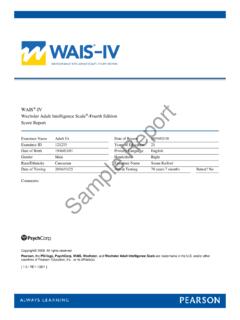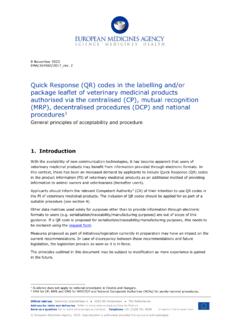Transcription of Involution: Inverting the Inherence of Convolution for ...
1 Involution: Inverting the Inherence of Convolution for visual RecognitionDuo Li1 Jie Hu2 Changhu Wang2 Xiangtai Li3Qi She2 Lei Zhu3 Tong Zhang1 Qifeng Chen1 The Hong Kong University of Science and Technology1 ByteDance AI Lab2 Peking has been the core ingredient of modern neu-ral networks, triggering the surge of deep learning in vi-sion. In this work, we rethink the inherent principles ofstandard Convolution for vision tasks, specifically spatial-agnostic and channel-specific. Instead, we present a novelatomic operation for deep neural networks by invertingthe aforementioned design principles of Convolution , coinedas involution. We additionally demystify the recent pop-ular self-attention operator and subsume it into our invo-lution family as an over-complicated instantiation.
2 Theproposed involution operator could be leveraged as fun-damental bricks to build the new generation of neural net-works for visual recognition , powering different deep learn-ing models on several prevalent benchmarks, including Im-ageNet classification, COCO detection and segmentation,together with Cityscapes segmentation. Our involution-based models improve the performance of convolutionalbaselines using ResNet-50 by up to top-1 accuracy, and bounding box AP, and mean IoU ab-solutely while compressing the computational cost to 66%,65%, 72%, and 57% on the above benchmarks, and pre-trained models for all the tasks are IntroductionAlbeit the rapid advance of neural network architectures, Convolution remains the building mainstay of deep neuralnetworks. Drawn inspiration from the classical image filter-ing methodology, Convolution kernels enjoy two remarkableproperties that contribute to its magnetism and popularity,namely, spatial-agnostic and channel-specific.
3 In the spa-tial extent, the former property guarantees the efficiency ofconvolution kernels by reusing them among different loca-tions and pursues translation equivalence [63]. In the chan-nel domain, a spectrum of Convolution kernels is responsi-ble for collecting diverse information encoded in differentchannels, satisfying the latter property. Furthermore, mod-ern neural networks appreciate the compactness of convolu-tion kernels via restricting their spatial span to no more than3 3, since the advent of the seminal VGGNet [42].On the one hand, although the nature of spatial-agnosticalong with spatial-compact makes sense in enhancing theefficiency and interpreting the translation equivalence, it de-prives Convolution kernels of the ability to adapt to diversevisual patterns with respect to different spatial , locality constrains the receptive field of convolu-tion, posing challenges for capturing long-range spatial in-teractions in a single shot.
4 On the other hand, as is knownto us all, inter-channel redundancy inside Convolution filtersstands out in many successful deep neural networks [23],casting the large flexibility of Convolution kernels with re-spect to different channels into conquer the aforementioned limitations, we presentthe operation coined asinvolutionthat has symmetricallyinverse inherentcharacteristics compared to Convolution ,namely, spatial-specific and channel-agnostic. Concretelyspeaking, involution kernels are distinct in the spatial ex-tent but shared across channels. Being subject to its spatial-specific peculiarity, if involution kernels are parameterizedas fixed-sized matrices like Convolution kernels and updatedusing the back-propagation algorithm, the learned involu-tion kernels would be impeded from transferring betweeninput images with variable resolutions.
5 To the end of han-dling variable feature resolutions, an involution kernel be-longing to a specific spatial location is possible to be gener-ated solely conditioned on the incoming feature vector at thecorresponding location itself, as an intuitive yet effective in-stantiation. Besides, we alleviate the redundancy of kernelsby sharing the involution kernel along the channel dimen-sion. Taken the above two factors together, the computa-tional complexity of an involution operation scales up lin-early with the number of feature channels, based on whichan extensive coverage in the spatial dimension is allowedfor the dynamically parameterized involution kernels. Byvirtue of an inverted designing scheme, our proposed invo-lution has two-fold privileges over Convolution : (i) involu-tion could summarize the context in a wider spatial arrange-ment, thus overcome the difficulty of modeling long-rangeinteractions well; (ii) involution could adaptively [ ] 11 Apr 2021the weights over different positions, so as to prioritize themost informative visual elements in the spatial , recent approaches have spoken for goingbeyond Convolution with the preference of self-attention forthe purpose of capturing long-range dependencies [39, 64].
6 Among these works, pure self-attention could be utilized toconstruct stand-alone models with promising , we reveal that self-attention particularizes ourgenerally defined involution through a sophisticated formu-lation concerning kernel construction. By comparison, theinvolution kernel adopted in this work is generated condi-tioned on a single pixel, rather than its relationship with theneighboring pixels. To take one step further, we prove inour experiments that even with our embarrassingly simpleversion, involution could achieve competitive accuracy-costtrade-offs to self-attention. Being fully aware that the affin-ity matrix acquired by comparing query with each key inself-attention is also an instantiation of the involution ker-nel, we question the necessity of composing query and keyfeatures to produce such a kernel, since our simplified in-volution kernel could also attain decent performance whileavoiding the superfluous attendance of key content, let alonethe dedicated positional encoding in presented involution operation readily facilitates vi-sual recognition by embedding extendable and switchablespatial modeling into the representation learning paradigm,in a fairly lightweight manner.
7 Built upon this redesignedvisual primitive, we establish a backbone architecture fam-ily, dubbed as RedNet, which could achieve superior per-formance over Convolution -based ResNet and self-attentionbased models for image classification. On the downstreamtasks including detection and segmentation, we comprehen-sively perform a step-by-step study to inspect the effective-ness of involution on different components of detectors andsegmentors, such as their backbone and neck. Involution isproven to be helpful for each of the considered components,and the combination of them leads to the greatest , our primary contributions are as follows:1. We rethink the inherent properties of Convolution , as-sociated with the spatial and channel scope. This mo-tivates our advocate of other potential operators em-bodied with discrimination capability and expressive-ness for visual recognition as an alternative, breakingthrough existing inductive biases of We bridge the emerging philosophy of incorporatingself-attention into the learning procedure of visual rep-resentation.
8 In this context, the desiderata of com-posing pixel pairs for relation modeling is , we unify the view of self-attention andconvolution through the lens of our The involution-powered architectures work universallywell across a wide array of vision tasks, including im-age classification, object detection, instance and se-mantic segmentation, offering significantly better per-formance than the Convolution -based Sketch of ConvolutionWe initiate from introducing the standard convolutionoperation to make the definition of our proposed involutionself-contained. LetX RH W Cidenote the input fea-ture map, whereH,Wrepresent its height, width andCienumerates the input channels. Inside the cube of a featuretensorX, each feature vectorXi,j RCilocated in a cellof the image lattice can be considered as apixelrepresent-ing certain high-level semantic patterns, with a little abuseof cohort ofCoconvolution filterswith the fixed kernelsize ofK Kis denoted asF RCo Ci K K, whereeach filterFk RCi K K,k= 1,2, ,Co, containsCiconvolution kernelsFk,c RK K,c= 1,2, ,Ciandexecutes Multiply-Add operations on the input feature mapin a sliding-window manner to yield the output feature mapY RH W Co, defined asYi,j,k=Ci c=1 (u,v) KFk,c,u+bK/2c,v+bK/2cXi+u,j+v,c,(1)where K Z2refers to the set of offsets in the neigh-borhood considering Convolution conducted on the centerpixel, written as ( indicates Cartesian product here) K= [ bK/2c, ,bK/2c] [ bK/2c, ,bK/2c].
9 (2)Moreover, depth-wise Convolution [8] pushes the formula-tion of group Convolution [27, 54] to the extreme, whereeach filter (virtually degenerated into a single kernel)Gk RK K,k= 1,2, ,Co, strictly performs Convolution onan individual feature channel indexed byk, so the first di-mension is eliminated fromFkto formGk, under the as-sumption that the number of output channels equals the in-put ones. As it stands, the Convolution operation becomesYi,j,k= (u,v) KGk,u+bK/2c,v+bK/2cXi+u,j+v,k.(3)Note that the kernelGkis specific to thekthfeature sliceX , ,kfrom the view of channel and shared among all thespatial locations within this Design of InvolutionCompared to either standard or depth-wise convolutiondescribed above,involution kernelsH RH W K K Gare devised to embrace transforms withinversecharacter-istics in the spatial and channel domain, hence its ,an involution kernelHi,j, , ,g RK K,g=Algorithm 1 Pseudo code of involution in a PyTorch-like style.
10 # B: batch size, H: height, W: width# C: channel number, G: group number# K: kernel size, s: stride, r: reduction ratio################### initialization ###################o = (s, s) if s > 1 else ()reduce = (C, C//r, 1)span = (C//r, K*K*G, 1)unfold = (K, dilation, padding, s)#################### forward pass ####################x_unfolded = unfold(x) # B,CxKxK,HxWx_unfolded = (B, G, C//G, K*K, H, W)# kernel generation, Eqn.(6)kernel = span(reduce(o(x))) # B,KxKxG,H,Wkernel = (B, G, K*K, H, W).unsqueeze(2)# Multiply-Add operation, Eqn.(4)out = mul(kernel, x_unfolded).sum(dim=3) # B,G,C/G,H,Wout = (B, C, H, W)return out1,2, ,G, is specially tailored for the pixelXi,j RC(the subscript ofCis omitted for notation brevity) locatedat the corresponding coordinate(i,j), but shared over the number of groups where each groupshares the same involution kernel.


![arXiv:0706.3639v1 [cs.AI] 25 Jun 2007](/cache/preview/4/1/3/9/3/1/4/b/thumb-4139314b93ef86b7b4c2d05ebcc88e46.jpg)
![arXiv:1301.3781v3 [cs.CL] 7 Sep 2013](/cache/preview/4/d/5/0/4/3/4/0/thumb-4d504340120163c0bdf3f4678d8d217f.jpg)
![@google.com arXiv:1609.03499v2 [cs.SD] 19 Sep 2016](/cache/preview/c/3/4/9/4/6/9/b/thumb-c349469b499107d21e221f2ac908f8b2.jpg)










![ABSTRACT arXiv:1409.1556v6 [cs.CV] 10 Apr 2015](/cache/preview/4/e/0/e/4/4/2/c/thumb-4e0e442c20fc4f8e108fa20a1095af07.jpg)


